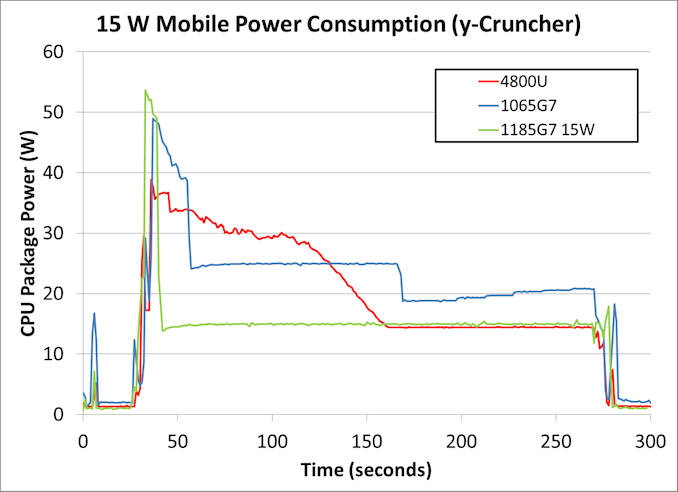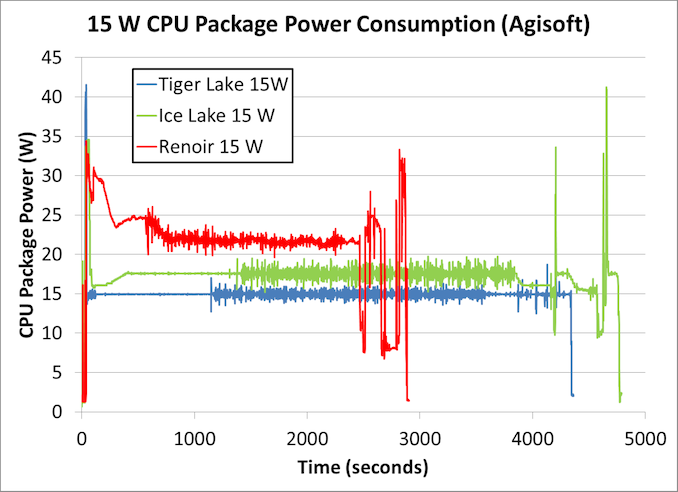Intel’s Tiger Lake 11th Gen Core i7-1185G7 Review and Deep Dive: Baskin’ for the Exotic
by Dr. Ian Cutress & Andrei Frumusanu on September 17, 2020 9:35 AM EST- Posted in
- CPUs
- Intel
- 10nm
- Tiger Lake
- Xe-LP
- Willow Cove
- SuperFin
- 11th Gen
- i7-1185G7
- Tiger King
Comparing 15 W TGL to 15 W ICL to 15 W Renoir
Despite the hullaballoo with the 28 W numbers on Tiger Lake, we suspect that most OEMs will still be positioning the hardware inside chassis built for the 15 W ultraportable market. This is where most of Intel’s OEMs have had success over the last decade, as the lower cooling requirements allow for a more user-friendly design. At 28 W, there is more of a cross-over into laptops that have discrete graphics options, and the main company that has succeeded in offering 28 W laptops without discrete graphics has been Apple - most Intel partners, if they want discrete graphics, end up looking at the 45 W processors with more cores.
So in that respect, our main battle should occur between the products built for 15 W. To that end we have been able to put the three together that will command this holiday season’s offerings: Ice Lake, Tiger Lake, and AMD’s Renoir.
- For our Ice Lake system, we have the Microsoft Surface Laptop 3. This has the top-of-the-line quad-core Core i7-1065G7, along with 16 GB of LPDDR4X-3733. Base 1.3 GHz, Turbo 3.9 GHz. Because this is an OEM design, Microsoft have determined the PL1 and PL2 values, and so they might be different from a ‘base’ design, however this is data from a real system.
- The Tiger Lake system is our Reference Design from Intel, running the quad-core Core i7-1185G7 at 15 W TDP mode. It has 16 GB of LPDDR4X-4266. Base 1.8 GHz, Turbo 4.8 GHz.
- Our AMD Renoir system is one of the most premium examples of AMD’s Ryzen Mobile in a 15W form factor, the Lenovo Yoga Slim 7 with the eight-core Ryzen 7 4800U processor. Even when set to the highest performance mode, the system still operates with a 15 W sustained power draw. It comes equipped with 16 GB of LPDDR4X-4266. Base 1.8 GHz, Turbo 4.2 GHz.
Compute Workload
For our 15 W comparisons, we can look again at the same benchmarks as the previous page. First up is y-Cruncher, an AVX2/AVX512 compute workload that tasks the CPU and the memory by calculating 2.5 billion digits of Pi, and requires ~11 GB of DRAM.
As we saw on the previous page, our Tiger Lake system in green at 15 W turbos up to ~53 watts before very quickly coming down to 15 W for the rest of the test.
The Microsoft Surface Laptop 3, by virtue of an OEM system, has different behavior - it turbos for longer, settles into a short turbo limit of 25 W, and then after about two minutes comes down to 20 W. The system then appears to opportunistically up the power draw until the end of the test, likely due to detecting extra thermal headroom.
The AMD Renoir processor does not turbo as high, peaking at only 38.9 W. Over the course of the next 100 seconds or slow, we see a small ramp down to just under 30 watts, before a more consistent decline over 30 seconds to 15 W, before staying at 15 W for the full test. The Renoir here has eight cores rather that four, but is running AVX2 rather than AVX-512 code.
The results are as follows:
- Ice Lake: 233 seconds, for 6072 joules, averaging 26.1 W
- Tiger Lake: 241 seconds for 4082 joules, averaging 17.0 W
- Renoir: 234 seconds for 5386 joules, averaging 23.0 W
All three systems perform the test in roughly the same amount of time, however the Tiger Lake system is very much ahead for efficiency. Tiger Lake effectively shaves off a third of the power from the previous generation Ice Lake system. We weren’t expecting this much of a jump from Ice Lake to Tiger Lake, but it would appear that Intel has done some work on the AVX-512 unit, and is putting that new high-performance transistor to use.
Professional ISV Workload
Moving onto the Agisoft test - as mentioned on the previous page, this is a 2D image to 3D modeling workflow where the algorithm comes in four stages, some of which prefer full multi-thread throughput, while others are more frequency and memory sensitive.
First, the Renoir finishes in almost half the time, mostly due to the fact that it has double the number of cores - there is no AVX-512 codepath in this test, and so all the processors rely on a mix of SSE, AVX, and perhaps some AVX2. That aside, the turbo behavior of Renoir is very interesting - we get almost 10 minutes of higher-than-base performance before the algorithm sets into a routine, hovering around 22 W. Because this test doesn’t attack the vector units as hard as the previous test, it may be a case that the Renoir system can manage the power distribution a bit better between the eight cores, allowing for the higher turbo.
Between the Ice Lake and the Tiger Lake, from the graph it would appear to be a double win for Tiger Lake, finishing in a shorter time but also consuming less power. The results are:
- 15 W Renoir: 2842 seconds for 62660 joules
- 15 W Ice Lake: 4733 seconds for 82344 joules
- 15 W Tiger Lake: 4311 seconds for 64854 joules
In this case, it’s a win for Renoir - a lot shorter time, and better power to boot, derived from the eight cores built on TSMC 7nm. Tiger Lake still represents a good jump over Ice Lake, offering 10% better performance at only 79% of the power, or a 13% increase in performance efficiency.












253 Comments
View All Comments
tipoo - Friday, September 18, 2020 - link
Sounds like their next Macbook releases are going to be Apple Silicon, not sure we'll ever see a TGL Apple system.AMDSuperFan - Thursday, September 17, 2020 - link
What worries me the most is that this Tiger is better than Renoir in every way possible. I feel like Intel is the Apple of laptops now and our AMD are some knockoff tablet with good specs but not up to snuff. This 4 core beating the 8 core Renoir is terrible. I know we have Big Navi coming and that should save us here, but right now the Nvidia and Intel products are really bad for us fans.Spunjji - Friday, September 18, 2020 - link
I worry about the mental health of the person running this account.eddman - Thursday, September 17, 2020 - link
Why intel didn't do 6-8 core low power models again? 10nm too power hungry? Low yields and/or low manufacturing capacity?Spunjji - Thursday, September 17, 2020 - link
Yes!But seriously, all of the above.
eek2121 - Thursday, September 17, 2020 - link
Fab capacity.RedOnlyFan - Friday, September 18, 2020 - link
Hahaha. Fake informationSpunjji - Friday, September 18, 2020 - link
What's your explanation then, Red? "They didn't want to"?They compete well with AMD at 15W but need 28W to get full performance from the design. Squeezing twice as many cores in would push them way, way off the bottom of their efficiency curve. They're running more complex cores than AMD and they require more power, no way around that.
If yields were good enough they'd have had 8-core Ice Lake designs out taking the fight back to AMD on the desktop, but mysteriously they skipped those and rehashed Skylake again. It's almost like something was holding them back...
JayNor - Thursday, September 17, 2020 - link
Intel chose to integrate high performance wifi6, thunderbolt 4, avx512, dlboost, pcie4 features rather than the more small hammers approach.Alder Lake will have even smaller and lower power cores than AMD's, so perhaps next year the choice for Cinebench processing will get funny.
RSAUser - Thursday, September 17, 2020 - link
You mentioned this again, so I'll comment again:WiFi 6/802.11ax: AMD does not do networking equipment, it's also not part of the CPU, it's an
extra module attached to the mobo.
PCIe 4: No benefit in laptops, there's no SSD that can really max it out consumer side and GPU wise. PCIe 4 consumes a lot more power than 3rd gen.
Thunderbolt 4: You actually mean USB 4.
AVX512: Not many things actually use this, a majority of those use-cases can just go GPU, and you're not really running an AVX512 workload on a laptop.
DLBoost: Intel's ML library, you're not training ML libraries on a laptop CPU, you'd near always want to use a GPU instead, plus that specific one is Intel's trademark one, you'd use open source alternatives.
AMDs' leaked roadmaps are USB 4 and PCIe 4 in 2022, and here you didn't mention LPDDR5, which is also included in that release.